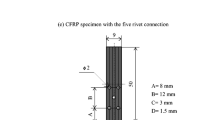Abstract
In this paper, CFRP specimens were processed with the configuration of opening mode to which various fiber laminate angles have been applied. It is possible to observe that the displacements of detachment at the adhesive interface differ from each other in both the experiment and analysis results. In case of the lamination at the angle of 30°, the detachment of adhesive interface occurred at the reaction force of 224 N with the progression of 5.24 m. In case of laminations at the angles of 45° and 60°, the detachment of bonded interface occurred with the reaction forces of 1134 N and 1100 N with the progressions of 4 mm and 4.7 mm, respectively. On the basis of these results, it was possible to discern that the differences in the detachment displacement of adhesive interface and reaction force occur according to the laminate angle in the CFRP with same material properties. Through this study result, it is thought that, unlike the existing woven type CFRP to which the laminate angle was not applied, securing of the basic fiber design data for manufacturing CFRP customized to the user’s environment will be able to make contributions towards the improvement of the strength and stability of the bonded CFRP structures.
Similar content being viewed by others
References
Bai, Y. L., Johnson, W., and Dodd, B., “On Tangential Velocity Discontinuities Being Coincident with Stress Discontinuities,” International Journal of Mechanical Sciences, Vol. 24, No. 5, pp. 323–328, 1982.
Kim, S.-S., Han, M.-S., Cho, J.-U., and Cho, C.-D., “Study on the Fatigue Experiment of TDCB Aluminum Foam Specimen Bonded with Adhesive,” Int. J. Precis. Eng. Manuf., Vol. 14, No. 10, pp. 1791–1795, 2013.
Parida, S. K. and Pradhan, A. K., “3D Finite Element Analysis of Stress Distributions and Strain Energy Release Rates for Adhesive Bonded Flat Composite Lap Shear Joints Having Pre-Existing Delaminations,” Journal of Mechanical Science and Technology, Vol. 28, No. 2, pp. 481–488, 2014.
Batra, R. and Peng, Z., “Development of Shear Bands in Dynamic Plane Strain Compression of Depleted Uranium and Tungsten Blocks,” International Journal of Impact Engineering, Vol. 16, No. 3, pp. 375–395, 1995.
Mukai, T., Miyoshi, T., Nakano, S., Somekawa, H., and Higashi, K., “Compressive Response of a Closed-Cell Aluminum Foam at High Strain Rate,” Scripta Materialia, Vol. 54, No. 4, pp. 533–537, 2006.
Cho, J. U., Hong, S. J., Lee, S. K., and Cho, C., “Impact Fracture Behavior at the Material of Aluminum Foam,” Materials Science and Engineering: A, Vol. 539, pp. 250–258, 2012.
Pirondi, A. and Nicoletto, G., “Fatigue Crack Growth in Bonded DCB Specimens,” Engineering Fracture Mechanics, Vol. 71, No. 4, pp. 859–871, 2004.
Shokrieh, M., Heidari-Rarani, M., and Rahimi, S., “Influence of Curved Delamination Front on Toughness of Multidirectional DCB Specimens,” Composite Structures, Vol. 94, No. 4, pp. 1359–1365, 2012.
Blackman, B. R. K., Dear, J. P., Kinloch, A. J., Macgillivray, H., Wang, Y., et al., “The Failure of Fibre Composites and Adhesively Bonded Fibre Composites under High Rates of Test,” Journal of Materials Science, Vol. 30, No. 23, pp. 5885–5900, 1995.
Marzi, S., Biel, A., and Stigh, U., “On Experimental Methods to Investigate the Effect of Layer Thickness on the Fracture Behavior of Adhesively Bonded Joints,” International Journal of Adhesion and Adhesives, Vol. 31, No. 8, pp. 840–850, 2011.
Cho, J.-U., Kinloch, A., Blackman, B., Rodriguez, S., Cho, C.-D., and Lee, S.-K., “Fracture Behaviour of Adhesively-Bonded Composite Materials under Impact Loading,” Int. J. Precis. Eng. Manuf., Vol. 11, No. 1, pp. 89–95, 2010.
Cooper, V., Ivankovic, A., Karac, A., McAuliffe, D., and Murphy, N., “Effects of Bond Gap Thickness on the Fracture of Nano-Toughened Epoxy Adhesive Joints,” Polymer, Vol. 53, No. 24, pp. 5540–5553, 2012.
Ghaffarzadeh, H. and Nikkar, A., “Explicit Solution to the Large Deformation of a Cantilever Beam under Point Load at the Free Tip Using the Variational Iteration Method-II,” Journal of Mechanical Science and Technology, Vol. 27, No. 11, pp. 3433–3438, 2013.
Goncalves, J., De Moura, M., and De Castro, P., “A Three-Dimensional Finite Element Model for Stress Analysis of Adhesive Joints,” International Journal of Adhesion and Adhesives, Vol. 22, No. 5, pp. 357–365, 2002.
Kim, K., Yoo, J., Yi, Y., and Kin, C., “The Strength and Failure Modes and of Singlelap Adhesively Bonded Composite Joints Formed Using Different Bonding Methods-Co-Curing With/Without Adhesive and Secondary Bonding,” Composite Structures, Vol. 25, No. pp. 45, 2005.
Crocombe, A. D. and Richardson, G., “Assessing Stress State and Mean Load Effects on the Fatigue Response of Adhesively Bonded Joints,” International Journal of Adhesion and Adhesives, Vol. 19, No. 1, pp. 19–27, 1999.
Han, M.-S., Choi, H.-K., Cho, J.-U., and Cho, C.-D., “Experimental Study on the Fatigue Crack Propagation Behavior of DCB Specimen with Aluminum Foam,” Int. J. Precis. Eng. Manuf., Vol. 14, No. 8, pp. 1395–1399, 2013.
Author information
Authors and Affiliations
Corresponding author
Rights and permissions
About this article
Cite this article
Hwang, G., Cho, J. Fracture Property on CFRP Specimen with Adhesive Interface according to Laminate Angle at Opening Mode. Int. J. Precis. Eng. Manuf. 19, 251–256 (2018). https://doi.org/10.1007/s12541-018-0029-8
Received:
Revised:
Accepted:
Published:
Issue Date:
DOI: https://doi.org/10.1007/s12541-018-0029-8




